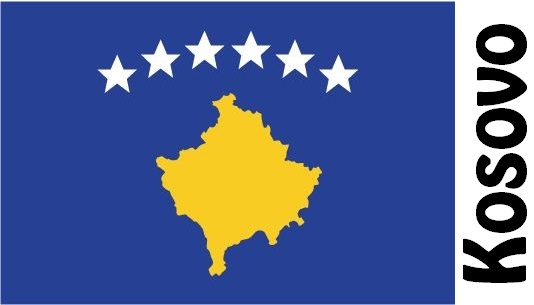Flags of Countries that Start with K
How many countries beginning with K? There are a total of 6 countries starting with letter K among the 193 countries in the world:
- Kazakhstan
- Kenya
- Kiribati
- Kosovo
- Kuwait
- Kyrgyzstan
Kosovo

Kosovo is a republic in the Balkans in southern Europe. The country is an inland state with borders to Albania, Macedonia, Montenegro and Serbia. Most of the country lies in a river basin surrounded by high mountain ranges.
The climate is mainland climate with cold, snowy winters and hot, dry summers.
In the past, the mining sector and the extraction of minerals and metals were important to the economy. But outdated technology in both industry and agriculture means that Kosovo is now one of Europe’s poorest countries.
Kosovo declared itself independent from Serbia in 2008. Previously, Kosovo was part of Serbia. Denmark and approx. 100 other countries have recognized Kosovo as an independent nation. Serbia still does not recognize Kosovo’s independence. About 90% of the population is Albanian.
Country Facts – State Capital – Population Graph
Kenya

Kenya is a republic in East Africa. The central and western parts of the country are a mountainous, volcanic highland intersected by the Rift Valley. In the NE there are desert and bush steppes, on the coast there are swampy lowlands. IN is located Lake Turkana, and in V is Lake Victoria.
The climate is tropical in the lowlands and more temperate in the highlands. Periods of drought occur in the eastern parts of the country.
Agriculture employs approx. 3/4 of the workforce. Among other things, corn, coffee, tea, beans, cereals, cotton and sisal. In addition to agricultural land, Kenya has few natural resources. Hydropower covers a smaller part of the energy demand.
Kenya was previously part of British Island Africa. The country became independent in 1963. Despite economic growth, approx. 50% of Kenya’s population is below the poverty line.
Country Facts – State Capital – Population Graph – Airports – Public Holidays – Embassies of Kenya – Embassies in Kenya – Import Regulations – Major Trade Partners – Major Imports – Major Exports
Kazakhstan

Kazakhstan is a republic in Central Asia Caspian Sea Island. The landscape consists mainly of dry bush and grass steppes, the two large lakes Aral and Balkhasj as well as desert in the S and high mountain ranges in the island and the lake.
There is a marked temperate mainland climate with large temperature fluctuations. The rainfall is greatest in the mountain areas.
The country is very rich in natural resources. oil, natural gas, coal, hydroelectric power, iron, copper and other metals as well as good soil and grassland for the large animal husbandry. Agriculture is irrigated. Kazakhstan has a smaller nuclear power plant.
Kazakhstan was a Soviet Union republic from 1936 to 1991, when it became independent. Declining living standards and corruption have led to social unrest since independence. In 2014, Kazakhstan and Belarus signed an agreement with Russia on the creation of a new Eurasian Union.
Country Facts – State Capital – Population Graph – Airports – Public Holidays – Embassies of Kazakhstan – Embassies in Kazakhstan – Import Regulations – Major Trade Partners – Major Imports – Major Exports
Kyrgyzstan

Kyrgyzstan is a republic in eastern Central Asia. Borders of China, Kazakhstan, Tajikistan and Uzbekistan. The landscape is dominated by several mountain ranges, i.a. The Tian Shan Mountains, as well as the vast plains.
The mainland climate is characterized by severe, cold winters in most of the country. IN is more temperate and in SV the climate is subtropical.
Agriculture is Kyrgyzstan’s most important profession. Among other things, wheat, barley, potatoes, sugar cane, tobacco, cotton and alfalfa. Irrigation is necessary in many places. The most important natural resources are agricultural land, hydropower, gold, coal, oil, natural gas, iron, mercury, antimony and zinc.
Kyrgyzstan was Soviet Union Republic 1936-1991. Since independence, the country has been plagued by political turmoil.
Country Facts – State Capital – Population Graph – Airports – Public Holidays – Embassies of Kyrgyzstan – Embassies in Kyrgyzstan – Import Regulations – Major Trade Partners – Major Imports – Major Exports
Kuwait

Kuwait is an emirate in the Arabian Peninsula of SV Asia. The country lies on the Gulf of Persia between Iraq and Saudi Arabia. The landscape is predominantly desert.
The climate is subtropical and desert-rich with hot summers and cool winters. Sandstorms occur frequently
Extraction and export of oil are fundamental to the economy. Kuwait holds approx. 1/10 of the world’s total oil reserves, and as a result, is a rich country.
From 1990, Kuwait was occupied by neighboring Iraq until international forces in 1991 (the Gulf War) forced Iraq to withdraw from the country. The war caused widespread destruction on several oil plants, roads, hospitals, schools and many other buildings in Kuwait.
Country Facts – State Capital – Population Graph – Airports – Public Holidays – Embassies of Kuwait – Embassies in Kuwait – Import Regulations – Major Trade Partners – Major Imports – Major Exports
Kiribati

Kiribati is a republic and an island nation in Oceania. The country encompasses 33 islands, the Gilbert Islands, the Phoenix Islands, some of the Line Islands, and the island of Banaba, in the southwestern Pacific. The islands are spread over a large sea area around the equator. With the exception of Banaba, the islands are low coral atolls formed by underwater volcanoes.
The climate is tropical, however moderated by trade winds.
Agriculture and fisheries are the main occupations, especially for the small, isolated, high self-sufficiency communities. Among other things, coconut, taros, pandanus, yams and bananas. Previously, phosphate was mined at Banaba.
Kiribati has been a British colony but became independent in 1979. 1942-1943 the islands were occupied by Japan. Kiribati is dependent on financial assistance.

Country Facts – State Capital – Population Graph – Airports – Public Holidays – Embassies of Kiribati – Embassies in Kiribati – Import Regulations – Major Imports – Major Exports













































